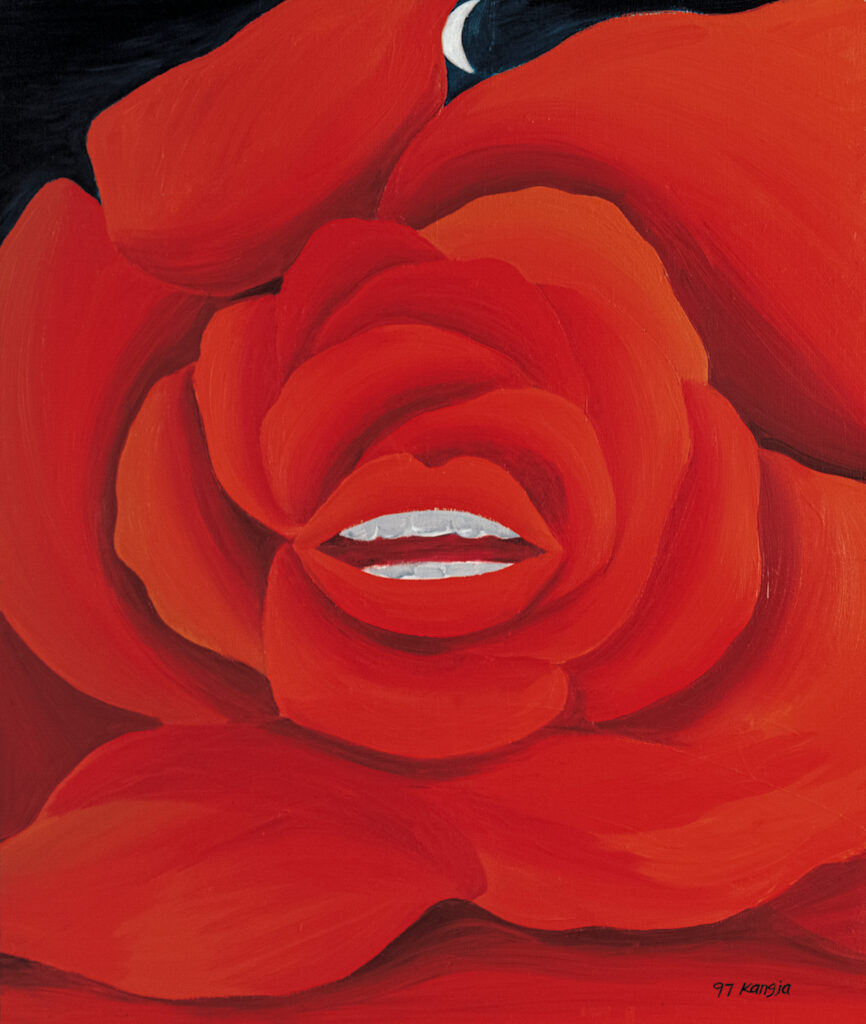나를 다시 부른 것은 원시였다
2023. 11. 15 - 12. 30 | [GALLERIES] ARARIO GALLERY SEOUL
정강자 (1942-2017)

정강자, 달과의 대화, 1997, Oil on canvas, 73x60cm
아라리오갤러리 서울은 2023년 11월 15일(수)부터 12월 30일(토)까지 정강자(1942-2017) 개인전 《나를 다시 부른 것은 원시였다》를 개최한다. 정강자는 한국 현대미술사에 한 획을 그은 대표적인 여성 아방가르드 작가이다. 국내 1세대 행위예술가로서 파격적인 퍼포먼스를 선보이며 1960-70년대 한국 실험미술의 발전에 크게 기여하였다. 첫 개인전 《무체전》(1970)의 강제 철거 이후 해외에서의 장기 체류를 택한 그는 1980년대 초 귀국한 이후 40여 년 간 수많은 회화 작품을 남겼다. 오랜 기간 국내 화단에서 정당한 평가를 받지 못했음에도 정강자는 예술을 삶 자체이자 그 목표로 삼으며 타계 직전까지 작품활동을 지속했다. 2000년대 이후 정강자에 대한 연구 및 재평가의 필요성이 제기되기 시작했다. 최근에는 국내외 미술계에서 그의 작품세계를 재조명하는 시도가 다각도로 이루어지고 있다. 이번 개인전은 2018년 아라리오갤러리 서울 및 천안에서 동시 개최한 회고전 이후 5년 만에 마련한 자리다. 정강자의 1995년부터 2010년까지 작품세계에 주목하여, 강렬하고 풍부한 색채와 특유의 도전의식이 돋보이는 회화 작품을 다양하게 선보인다.

정강자, 뜨개질로 우주를, 1995-96, Oil on canvas, 162x130cm
아라리오갤러리 서울 지하 1층 및 1층 공간은 정강자의 1990년대 작품세계를 조명한다. 1980년대부터 1990년대 초반까지 작가는 중남미, 아프리카, 서남아시아, 남태평양 등 다양한 세계를 여행하며 이국적인 풍경과 인물들을 화폭에 담았다. 순수한 자연과 원시의 삶을 찾아 떠난 여정이었다. 낯선 세상을 탐험하며 마주한 장면들에 스스로의 꿈이 투영된 환상적 이미지를 접목하여 회화로 기록했다. 이 시기 화면은 넓은 세계를 누비며 얻은 시각적 경험을 드러내는 동시에 역설적으로 더 깊숙한 작가의 내면세계를 보여준다. 다채로운 색상과 그만의 상상력이 돋보이는 구성으로 독자적인 초현실적 화면을 제작해 낸 시기다. 1990년대 후반부터는 보다 추상적이고 초월적인 형태에 관심을 두기 시작했다. 한복의 형상을 재해석하여 조형요소로 활용하는 등 모국의 전통을 상징하는 소재에 집중한 면모가 두드러진다. 화면 속 다양한 상징들은 작가의 삶과 철학, 여성 예술가로서의 정체성과 강렬한 감수성을 함축적으로 드러낸다. 정강자는 한복 치마가 “수천 년을 남성우월주의의 지배에서 억압받은 우리 여인들의 깃발”이자 “어머니를 생각하면 떠오르는 것”이라고 했다. 오래도록 여성의 가슴을 짓눌러 온 치마끈은 하늘을 훨훨 날아다니기도 하고, 산처럼 쌓여 거대한 기념비가 되기도 한다.

정강자, 무제, ca. late 1990s, Oil on canvas, 130x162cm
3층과 4층 공간에서는 정강자의 2000년대 작품들을 만나볼 수 있다. 원시적 풍경을 바탕 삼아 더욱 깊고 내밀한 내면세계를 탐구해 나아간 시기다. 스스로의 분신이자 아이콘(icon)이라고 여긴 야누스(Janus)의 형상이 화면에 자주 보인다. 우주 만물의 최소 단위를 상징하는 원에 인위적인 직선을 결합해 만든 반원은 말년의 화폭에 두드러지게 등장하는 요소다. 모든 형태를 기하학적으로 환원하는 실험에 집중한 흔적이 엿보인다. 회화의 언어로써 당대의 억압적 현실과 스스로의 억눌린 욕망을 해소하려는 바람을 가늠해볼 수 있다. 화면 속 무한한 자유 공간에서 펼쳐 낸 상상을 통하여 자기 자신을 해방시키고자 한 것이다. 정강자는 작고 직전까지 작업에 전념했다. 그가 남긴 화면들은 한국 현대사의 격동적 시기를 몸소 겪은 한 여성 예술가의 삶과 열정을 고스란히 드러낸다.

정강자, 무제, 2000, Oil on canvas, 61x73cm
정강자는 1942년 대구에서 태어났으며 홍익대학교 서양화과를 졸업했다. 한국 실험미술의 발전을 이끈 1세대 행위예술가이자 대표적인 여성 아방가르드 작가로서 우리 현대미술사에 의미 있는 족적을 남겼다. 그간 충분한 연구와 조명이 이루어지지 않은 바, 국내외 미술계에서 그의 작품세계에 대한 재평가가 이루어지고 있다. 《역사를 몸으로 쓰다》(국립현대미술관, 과천, 2017), 《아시아 여성미술가들》(전북도립미술관, 완주, 2017), 《정강자: 마지막 여행은 달에 가고 싶다》(아라리오갤러리 서울 및 천안, 2018), 《정강자: 꿈이여 환상이여 도전이여》(아라리오뮤지엄 인 스페이스, 서울, 2023) 등 주요 미술기관이 정강자의 작품세계를 조명하는 전시를 개최했다. 최근 국립현대미술관에서 성황리에 막을 내린 후 뉴욕 구겐하임 미술관을 순회 중인 전시 《한국 실험미술 1960-70년대(Only the Young: Experimental Art in Korea, 1960s-1970s)》(2023-2024)에 작품이 선보여 주목 받기도 했다. 해당 전시는 2024년 로스앤젤레스 해머미술관 순회를 앞두고 있다. 국립현대미술관, 서울시립미술관, 수원시립미술관, 아라리오뮤지엄 등이 정강자의 작품을 소장 중이다.

JUNG Kangja, It Has Always Been The Beginning, Installation View_Arario Gallery Seoul_3F(2)
아라리오갤러리 서울
서울시 종로구 율곡로 85
02 541 5701
[GALLERIES] ARARIO GALLERY SEOUL
- Dates
- 2023. 11. 15 - 12. 30











